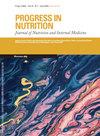Raw red onion intake and insulin resistance markers in overweight or obese patients with polycystic ovary syndrome: a randomized controlled-clinical trial
4区 医学
Q4 Agricultural and Biological Sciences
引用次数: 3
Abstract
Background: Insulin resistance (IR) plays a pivotal role in the development of polycystic ovary syndrome (PCOS). Though hypoglycemic and hypolipidemic effects of onion have been suggested in type 2 diabetes mellitus, still, lack of data exist to investigate its hypoglycemic effect in PCOS. Objective: to assess the effects of raw red onion consumption on IR markers in PCOS. Methods: In this randomized controlled-clinical trial, 53 overweight or obese non-diabetic patients with PCOS were randomly allocated to either group of high-onion (HO; raw red onions: 2×40-50 g/day for overweight and 2×50-60 g/day for obese patients) or low-onion (LO; raw red onions: 2×10-15 g/day) for an 8 weeks. Fasting and 2-hour blood sugar, insulin, total testosterone, and progesterone, as well as homeostasis model of insulin resistance (HOMA-IR) and quantitative insulin sensitivity check index (QUICKI) were measured at baseline and after treatment. IR was defined as HOMA-IR≥3.8 in PCOS. Anthropometric indices and dietary intake were also evaluated. Results: After 8 weeks, no differences were observed in the IR markers including HOMA-IR neither within nor between the HO (from 3.53±1.22 to 4.08±1.70; P=0.090) and LO groups (from 3.58±1.75 to 3.32±1.36; P=0.338). Anthropometric and dietary parameters did not differ between the two groups (P>0.050). However, a non-significant increase was observed in the rate of menses occurrence in HO (17%) compared to LO group (6%) after 8 weeks. Conclusions: Although raw red onion intake could not significantly improve IR markers in non-diabetic patients with PCOS, it could increase the chance of menses occurrence. Further investigations are warranted to determine the effects of onion in these patients.超重或肥胖多囊卵巢综合征患者的生红洋葱摄入量和胰岛素抵抗标志物:一项随机对照临床试验
背景:胰岛素抵抗(IR)在多囊卵巢综合征(PCOS)的发展中起着关键作用。尽管洋葱对2型糖尿病有降血糖和降血脂作用,但仍缺乏研究其对多囊卵巢综合征的降血糖作用的数据。目的:探讨生食红洋葱对多囊卵巢综合征(PCOS)IR标志物的影响。方法:在这项随机对照临床试验中,53名超重或肥胖的非糖尿病PCOS患者被随机分配到高洋葱组(HO;生红洋葱:超重患者2×40-50 g/天,肥胖患者2×50-60 g/天)或低洋葱组(LO;生红葱:2×10-15 g/天),为期8周。在基线和治疗后测量禁食和2小时血糖、胰岛素、总睾酮和孕酮,以及胰岛素抵抗稳态模型(HOMA-IR)和定量胰岛素敏感性检查指数(QUICKI)。PCOS的IR定义为HOMA-IR≥3.8。还对人体测量指标和饮食摄入量进行了评估。结果:8周后,HO组(3.53±1.22至4.08±1.70;P=0.090)和LO组(3.58±1.75至3.32±1.36;P=0.038)的IR标志物(包括HOMA-IR)均无差异。两组之间的人体测量和饮食参数无差异(P>0.05)。然而,与LO组(6%)相比,HO组的月经发生率(17%)在8周后没有显著增加。结论:尽管生红洋葱摄入不能显著改善非糖尿病PCOS患者的IR标志物,但它可能会增加月经发生的机会。需要进一步的调查来确定洋葱对这些患者的影响。
本文章由计算机程序翻译,如有差异,请以英文原文为准。
求助全文
约1分钟内获得全文
求助全文
来源期刊

Progress in Nutrition
医学-营养学
CiteScore
1.40
自引率
0.00%
发文量
0
审稿时长
>12 weeks
期刊介绍:
Progress in Nutrition was founded in 1999 as an independent magazine, a multidisciplinary approach, dedicated to issues of nutrition and metabolism.
 求助内容:
求助内容: 应助结果提醒方式:
应助结果提醒方式:


